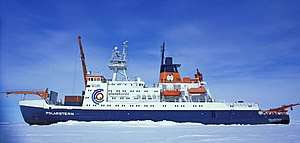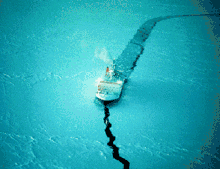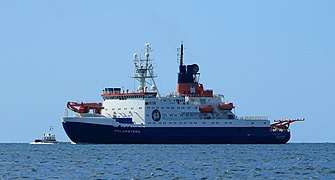RV Polarstern
RV Polarstern (meaning pole star) is a German research icebreaker of the Alfred Wegener Institute for Polar and Marine Research (AWI) in Bremerhaven, Germany. Polarstern was commissioned in 1982 and is mainly used for research in the Arctic and Antarctica. It is planned that she will be replaced by Polarstern II around the year 2020,[2] after it was decided that the European Research Icebreaker Aurora Borealis will not be built in her original form.
 | |
| History | |
|---|---|
| Name: | Polarstern |
| Namesake: | Pole star |
| Owner: | Bundesministerium für Bildung und Forschung[1] |
| Operator: | Alfred Wegener Institute (AWI) |
| Port of registry: | Bremerhaven, Germany |
| Route: | Arctic and Antarctica |
| Ordered: | 28 August 1980[1] |
| Builder: | Howaldtswerke-Deutsche Werft at Kiel and the Nobiskrug at Rendsburg |
| Yard number: | 707[1] |
| Laid down: | 22 September 1981[1] |
| Launched: | 6 January 1982[1] |
| Completed: | 8 December 1982[1] |
| Identification: |
|
| Status: | In service |
| General characteristics | |
| Type: | Icebreaker, Research vessel |
| Tonnage: | 12,614 GT[1] |
| Displacement: | 17,300 tonnes |
| Length: | 117.91 m (386 ft 10 in) |
| Beam: | 25.07 m (82 ft 3 in) |
| Draught: | 11.21 m (36 ft 9 in) |
| Installed power: | Four diesel engines, 14,000 kW (19,000 hp) |
| Speed: | 15.5 knots (28.7 km/h; 17.8 mph) |
| Capacity: | 124 persons |
| Crew: | 44 |
Polarstern was built by Howaldtswerke-Deutsche Werft in Kiel and Nobiskrug in Rendsburg. The ship has a length of 118 metres (387 feet) and is a double-hulled icebreaker. She is operational at temperatures as low as −50 °C (−58 °F) Polarstern can break through ice 1.5 m (4 ft 11 in) thick at a speed of 5 knots (9.3 km/h; 5.8 mph). Thicker ice up to 3 m (9.8 ft) thick can be broken by ramming.
History
On 7 September 1991, Polarstern, assisted by the Swedish arctic icebreaker Oden reached the North Pole as the first conventional powered vessels.[3] Both scientific parties and crew took oceanographic and geological samples and had a common tug of war and a football game on an ice floe. In 2001, Polarstern together with USCGC Healy reached the pole again.[4] She returned for a third time on 22 August 2011. This time she reported the most frequently recurring ice thickness at 0.9 m (2 ft 11 in) compared with 2 m (6 ft 7 in) in 2001.[5]
On 2 March 2008, one of the vessel's helicopters crashed on a routine flight to the Antarctic Neumayer II base. The German pilot and a Dutch researcher were killed, three other passengers were injured.[6][7]
On 17 October 2008, Polarstern was the first research ship ever to travel through both the Northeast Passage and the Northwest Passage in one cruise, thus circumnavigating the North Pole.[8]
On 20 September 2019, she sailed from Tromsø, Norway, for a 12 to 14 month-long Multidisciplinary drifting Observatory for the Study of Arctic Climate (MOSAiC) expedition across the Arctic.[9][10] She settled in an ice floe on 4 October 2019 and will drift in it past the North pole eventually reaching open water in the Fram Strait.[11] While stuck in the ice in March 2020, a member of the aircraft team who had not yet joined the ship in the Arctic tested positive for COVID-19. This resulted in the entire aircraft team being placed in isolation in Germany and caused delays in the retrieval of scientific data from around the ship to provide context to the data taken aboard.[12]

Expeditions updates
Current listings of all cruises on board Polarstern as well as associated content (e.g., tracklines, weekly reports, cruise reports, publications and data) are presented in AWI's research platform portal.[13]
In popular culture
The ship plays a central role in German musician Schiller's 2010 album Atemlos (German for breathless). A track is titled after the ship. It is also featured in the DVD of the same title, showing the musician's expedition on the vessel.
Gallery
 Polarstern near Reykjavík, Iceland
Polarstern near Reykjavík, Iceland Library in the blue saloon
Library in the blue saloon
References
- "Polarstern (G16829)". DNV GL Vessel Register. Germanischer Lloyd. Retrieved 11 April 2016.
- "Ausschreibung Nachfolgebau Polarstern" [Polarstern's Successor Announced] (in German). Federal Ministry of Education and Research (Germany). Retrieved 18 July 2017.
- Fütterer, D. et al. (1992) The Expedition ARK-VIII/3 of RV Polarstern in 1991, Reports on Polar and Marine Research, Bremerhaven, 107, 267 pp, hdl:10013/epic.10107.d001 (pdf 6.4 MB)
- Thiede, J. et al. (2002) POLARSTERN ARKTIS XVII/2 Cruise Report: AMORE 2001 (Arctic Mid-Ocean Ridge Expedition), Reports on Polar and Marine Research, Bremerhaven, 421, 390 pp, hdl:10013/epic.10426.d001 (pdf 8 MB)
- "Research Vessel Polarstern at North Pole". August 24, 2011. Archived from the original on 12 February 2013. Retrieved 12 September 2011.
- "(ANT-XXIV/3 Weekly report No. 3)". Archived from the original on 17 November 2009. Retrieved 30 March 2008.
- "The crash in retrospect" (in Dutch). Archived from the original on 24 July 2011. Retrieved 28 March 2008.
- "idw-online.de - Research around the North Pole". Retrieved 2008-10-20.
- Henry Fountain (19 September 2019). "Scientists to Drift With Arctic Ice to Study Climate Change". The New York Times. Retrieved 5 October 2019.
- "An entire year trapped in the ice". MOSAiC. Alfred Wegener Institute. Retrieved 5 October 2019.
- Henry Fountain (4 October 2019). "Scientists on Arctic Expedition Choose Ice Floe That'll Be Home for a Year". The New York Times. Retrieved 5 October 2019.
- Giuliana Viglione (11 March 2020). "Coronavirus crisis hits ice-locked Arctic research expedition". Nature. Retrieved 1 April 2020.
- AWI's research platform portal
External links
| Wikimedia Commons has media related to PFS Polarstern. |